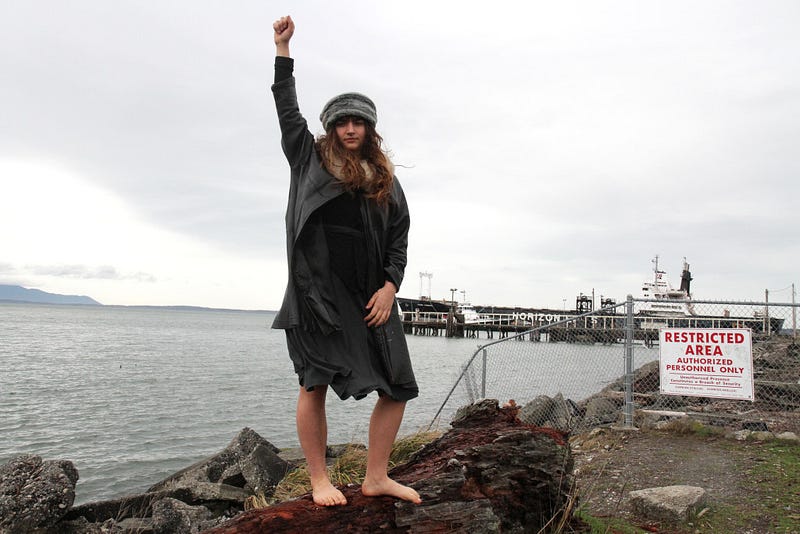Law and Activism by Land and Sea
Chiara D’Angelo-Patricio shares her experiences as a young woman with a passion for protecting the environment
STORY BY PAOLO BICCHIERI | PHOTOS BY BEATRICE HARPER
A gluten-free, vegan, strawberry chocolate Bundt cake is held in front of the birthday girl. The lights go out and the glow of candlelight illuminates her face. It is Feb. 28th, one day before Chiara D’Angelo-Patricio’s 21st birthday. A wreath of dried roses adorns her neck while friends and family sing in unison as she thinks about what to wish for.
D’Angelo-Patricio climbed the chain of the Arctic Challenger’s anchor in May of 2015. This ship was among a fleet heading to the Chuckchi Sea in the Arctic Ocean for oil drilling. Other activists showed up in kayaks, many of them who, like D’Angelo-Patricio, are facing legal consequences.
D’Angelo-Patricio has a connection with the sea, she says. Growing up on Bainbridge Island, Wash. she remembers swimming in the ocean under the moonlight, her favorite time to be the water. She attended Islandwood, a private school located on the island that teaches environmental consciousness using alternative learning methods. It was there that she learned the waters of the Puget Sound were in danger, she says.
“That upset her deeply,” says Debra D’Angelo, Chiara’s mother, who was there to see her daughter hanging in a hammock from the Arctic Challenger’s anchor for 63 unbroken hours last spring.
“Spirit never leads me wrong,” D’Angelo-Patricio says.
But the Coast Guard says their rules were clear and, regardless of spirit, D’Angelo-Patricio and other activists were warned to stay clear of the barge. The Coast Gaurd had formed a 100-yard safety zone and a 500-yard transitioning safety zone for navigation in the Bellingham Bay without interfering with the Arctic Challenger. D’Angelo-Patricio’s demonstration violated these zones. While attempting to visit the boat, Debra and fellow activist Paul Adler were also fined.
Lieutenant Commander Darain Kawamoto is a Chief of Investigations in the U.S. Coast Guard’s (USCG) Puget Sound’s Sector 13. Kawamoto says that the USGC stance has remained that the protesters may protest — it’s their right — but that they need to do so safely.
“There’s a fine line between protesting and a safety issue — safety for the person and the vessel,” Kawamoto says.
Sector 13 has proposed an initial fine of $20,000 for D’Angelo-Patricio.
Kawamoto says he Captain Joe Raymond reached out to sHELLNO and 350 before their action to inform them of the safety zones. The zones were created on April 28th, nearly a month prior to the protesters ascension.
Amanda Schmekes, a lawyer working with the Climate Defense Liberties Center (CDLC), and Lauren Regan, Director of the CDLC, are representing D’Angelo-Patricio. The CDLC take on cases like hers pro-bono, especially those setting a precedent. The CDLC team says that though some activists may have been alerted this did not mean D’Angelo knew about this special zone.

Her team is arguing a necessity case. Legally, this means that the defendant had no choice but to break the law. The CDLC is making this case on the grounds that climate change needs to be addressed. The team cites Columbia University climatologist James Hansen throughout their defense.
The USCG could charge D’Angelo-Patricio the proposed $20,000, or up to $40,000 for each day spent violating the zone. Regen says that for a 20-year-old with no bank account that’d be extreme. The CDLC proposes 63 hours of community service; one hour for each hour disrupting the Coast Guard.
D’Angelo-Patricio is only worried that USCG won’t see the positivity in her action. She’s worried nothing good will come from it; she’s worried for the environment.The D’Angelos plan to appeal in the event of monetary punishment.
The CDLC says that this type of old-school activism could be one of the few resources for citizens in the future. This case is one with the potential to change some standards for environmental protection and activism.
“It’s intimidating,” D’Angelo-Patricio says. “I don’t want the attention — I just want the sea to be healthy.”
The USCG opted for a closed session in Seattle’s Henery M. Jackson Federal Building. Chiara, Debra and her attorneys along with the media were allowed into a USCG courtroom about 15 minutes before the hearing began.
Lieutenant Commander Scott Klinke made a video call to the session from Washington. He will be the judge and jury deciding D’Angelo-Patricio’s fate.
She believes the environmental justice movement is about showing a vulnerability to people that they can relate to.
The essence of vulnerability is power, she says.
“You have no intention of doing this again? Pledge to me today that you will not violate a safety zone without authorization,” Klinke says. D’Angelo-Patricio says she has no future plans to tie herself to an anchor in hopes of stopping an oil ship. She already succeeded.
“To try and save the planet, community support is important,” Schemkes says.
A new group has been formed out of this resistance; the Coastal Guardians.
D’Angelo-Patricio will graduate in the spring from Western’s Fairhaven College with a concentration in Systems
Thinking for Ethnic and Ecological Justice. In many ways she is just like any other college student — hanging out with her friends and taking road trips on the weekends. But she maintains a unique ambition. Her dedication to environmental justice is apparent in nearly everything she does. There is a passion in her eyes and smile.
